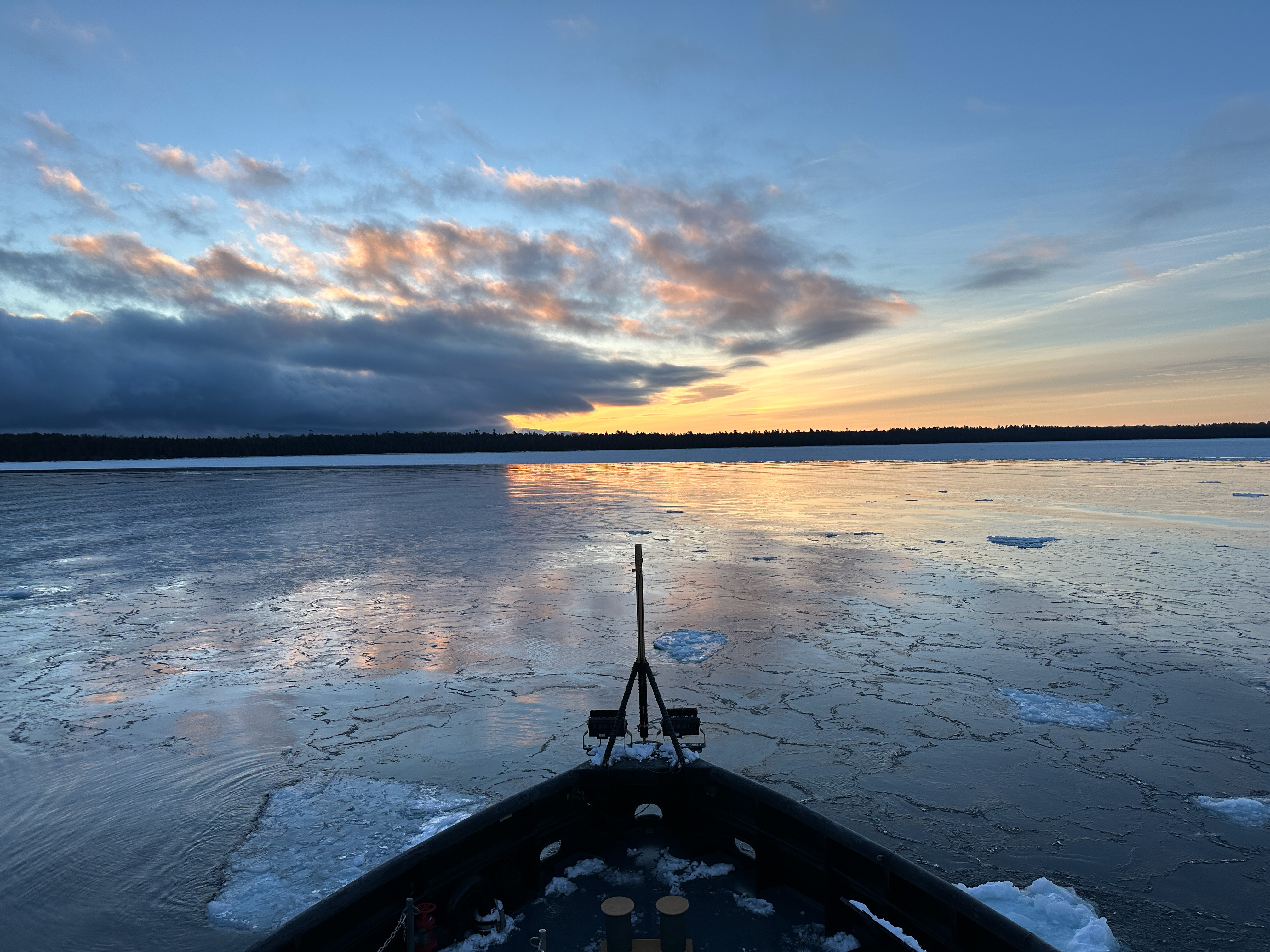John Saran, a public affairs specialist from District nine, went underway with the Katmai Bay to learn more about the cutter’s icebreaking mission on the Great Lakes and what makes the Katmai Bay the best place to work.
Late last month, when a cargo ship accident temporarily closed a critical river passage between the U.S. and Canada, the US Coast Guard Cutter Katmai Bay stepped in to help. Although their 76-day icebreaking mission had ended just the day before, the 17-person crew quickly set up a Search and Rescue (SAR) platform –joining two small boats and an MH-60 Jayhawk from Air Station Traverse City to provide support. Fortunately, the ship, American Mariner, caused no injuries when it struck the Mud Lake Junction Light in the St. Mary’s River. It did begin taking on water, however, so the Katmai Bay remained on scene until the vessel was safely moved out of the channel and commercial traffic could resume.
 |
If you are considering potential duty stations or wondering what it’s like to serve aboard an icebreaker, you might want to consider the Katmai Bay (WTGB-101), or one of the five other Bay Class cutters in the Great Lakes. You’ll have the opportunity to lead and master the art of being a mariner, while helping keep the channels of international trade open for business. Meanwhile, the skills you’ll learn in this tight knit crew are directly transferable to other units in the cutter fleet.
What they do: The Bay Class cutters (of which Katmai Bay was the first) are the only U.S. icebreakers dedicated solely to the domestic icebreaking mission. While Katmai Bay’s strong bow initially breaks ice, at icebreaking speed (10.4 knots) the 140-foot tugboat creates a wake behind it that is five ship-widths. With just an initial pilot trail, and then one full pass through at speed, the Katmai Bay can create a large channel for commercial vessel activity in ice 3-5 feet thick.
The Katmai Bay also has an air lubrication system, often called the “bubbler,” that comprises a series of holes in the hull that can release air similar to an air hockey table. This system helps with reducing friction around the hull, allowing the ship to proceed faster through thicker ice.
“This vessel was built for ice,” said Lt. Michael Overstreet, CGC Katmai Bay commanding officer. “It's small footprint allows us to maneuver very close to other ships and near shoals, both of which present challenges for larger cutters.”
What busy season looks like: This past winter was relatively warm, with the National Oceanic and Atmospheric Administration (NOAA) recording “the lowest Jan ice cover on record in the Great Lakes.” The six Great Lakes icebreakers did not remain on the sidelines. In fact, together they logged more than 719 hours of icebreaking assistance over the two and a half months of Operation TACONITE. They supported 52 vessel transits, including 18 direct escorts. These efforts ensured commercial shipping lanes remained open and that vital cargo worth $67 million reached its destinations to sustain the power grid and industrial output.
After coming off of an eventful summer break, the Sault Ste. Marie, Michigan, crew of the Katmai Bay had an even busier icebreaking season. The Katmai Bay’s icebreaking is done in sprints that last a few days. These sprints are mostly centered around the tighter waterways of the regions, including the Straits of Mackinac and the St. Mary’s River.
Why it's fulfilling: As non-rated members reported to the Katmai Bay from Cape May, they are immediately placed into roles as deckhands, engineers, helmsmen, and lookouts. Some had never been on boats before, never experienced the cold weather nor traveled much outside of their hometowns.
Seaman Zakarya Bentameur takes pride in their ability to quickly prepare the cutter to get underway.
“In the beginning, it seems like chaos,” said Bentameur. “But as you gain more experience and see the results of your work, you realize that there is a process.”
Having a small crew, with an average age of 27, allows everyone to get to know each other. It also lets new members gain significant experience that they might not get at other units they get their start.
"I prefer a smaller unit,” said Chief Petty Officer Stephan Mattke. “It is more a family environment where you foster the crew's careers to get them to go where they need to go as senior enlisted."
What they do for fun: With the daily routine and cold weather operations comes the need to maintain crew morale. That starts in the galley with Petty Officer 2nd Class Vincent Colonna's cooking. He is known for making dishes that the crew loves, which are especially appreciated after facing the bone-chilling wind.
Why it’s great to live where they do: A crew favorite is bonfire night on Lime Island. After mooring, the crew will disembark, start a fire, and stargaze while enjoying delicacies reserved for special occasions. Michigan’s Upper Peninsula in the winter is serene. “Ice Liberty” can also be a perfect setting for a unit morale event.
Best-kept secret: “Icebreaking tugboats on the Great Lakes will absolutely prepare you for a career in cutter operations,” said Lt. Bryant Giorgi, Katmai Bay’s executive officer. “You will probably enjoy yourself, even accounting for the cold winters. I highly recommend it as a first unit or next assignment,”
For more information on the Katmai Bay, check out their unit information sheet here.
Is your unit the best place to work? Let us know!
-USCG-